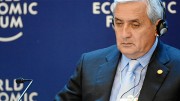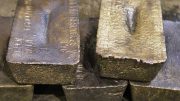Gold has been one of the leading subsectors of mining in recent months, particularly with the fading prices of stalwarts copper and iron ore.
And so with spot gold prices sinking briefly below US$1,200 per oz. again on Feb. 18, it’s adding a few more jitters to the mining sector, as it looks out into what’s shaping up to be a tough 2015.
Gold started this year with a good run up to the US$1,300 per oz. level, rising from a London PM fix of US$1,172 per oz. on Jan. 2 to peak at US$1,295.75 per oz. on Jan. 22, and even briefly hitting US$1,306 per oz. in intraday trading as gold majors’ stocks were suddenly in vogue again for day traders. But now almost all of those January gold price gains have been erased.
Silver prices have marched in lockstep with gold so far in 2015, fixing at US$15.71 per oz. on Jan. 2 before peaking at US$18.23 per oz. on Jan. 23, and retreating to today’s sobering US$16.50 per oz.
That US$1,300 per oz. level for gold prices is a critical one for gold miners, as gold market specialist GFMS estimates that the global gold-mining industry’s all-in costs, excluding impairments, was US$1,300 per oz. for the first nine months of 2014.
While it says gold miners “remain in a precarious position” at US$1,300 per oz. gold, GFMS sees some upside in that “good husbandry over the past two years has, however, put a number of projects back on the shelf,” and it believes that 2014 may have been the peak in global gold mine production.
We’ve heard from many different quarters over the past decade that gold production had finally peaked and would plateau before declining, as the world’s richest and shallowest mines are depleted. But you just can’t discount the relentless drive of gold miners large and small all over the world to increase output: according to the World Gold Council, gold mine production hit an all-time record of 3,114.4 tonnes (100.1 million oz.) in 2014 — up a whopping 2% from 2013 and the sixth straight year of increase.
Helping counteract the mine supply surge was sharp contraction in gold recycling, which dropped to a seven-year low. Part of the reason for this, GFMS says, is the “toughening of regulations with respect to money laundering in a number of countries.”
The World Gold Council similarly believes the next couple of years may be the time when mine production finally “caps out,” as the supply pipeline thins due a relative lack of investment in new mines over the past few years in response to lower gold prices and cost pressures.
The demand side of the gold equation was relatively muted in 2014 after a wild 2013, when professional investors in the West dumped gold and Asian investors stocked up on physical supply.
GFMS underscores that 2014 saw the second highest official-sector net purchases in gold since the Bretton Woods agreement ended in 1971. It found that Russia was an “exceptionally strong gold buyer” last year, having the highest annual reported purchases since the break up of the U.S.S.R.
GFMS also sees jewellery fabrication and investment bar and coin demand bottoming out in 2015 after declines of 11% and 40% in 2014.
While not calling an outright bull market, it sees that the market’s dynamics “are more settled as we move into 2015,” with underlying physical demand starting to build again, which will give the market “longer-term ballast.”
Meanwhile, as we go to press, the minutes from the latest Federal Open Market Committee (FOMC) meeting of the U.S. Federal Reserve have been released, and they state that the Fed will remain patient on moving to raise interest rates.
The Fed showed particular concern over falling oil prices, and the overall dovishness seen in the minutes point many to conclude there will not be an interest rate hike from the FOMC at the June meeting. While not overtly bullish for gold, the added certainty is welcome by gold investors.
None of the above developments makes one ready to bang the table that a new gold bull market is upon us, but at least they are good signs that a strong base is being built into the gold market at the US$1,200 per oz. level.




Be the first to comment on "Editorial: Gold prices building a base, hopefully"